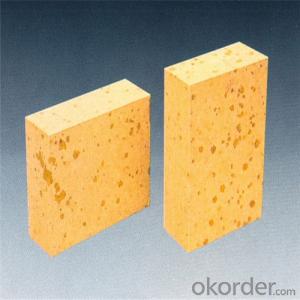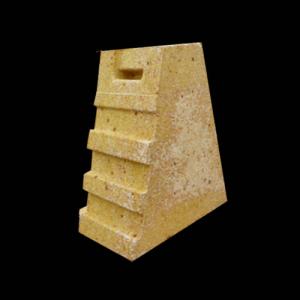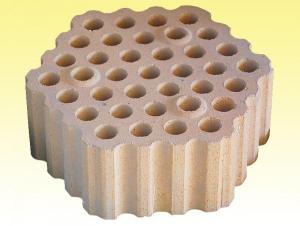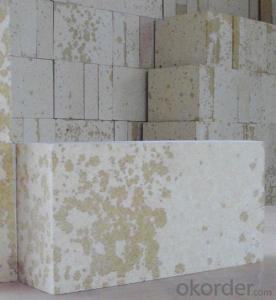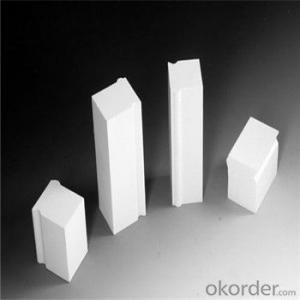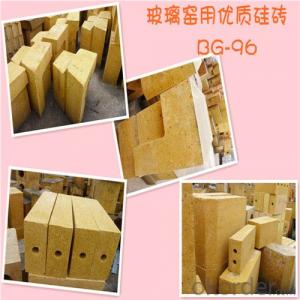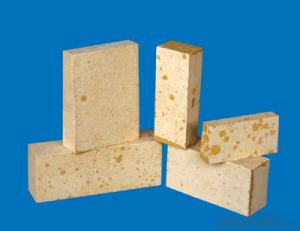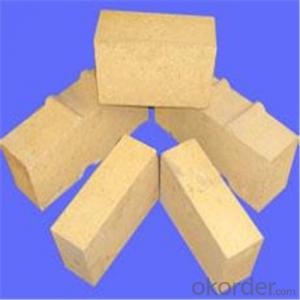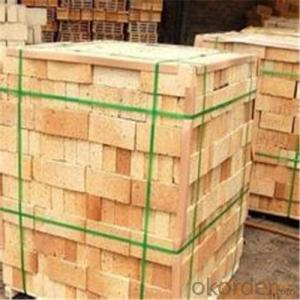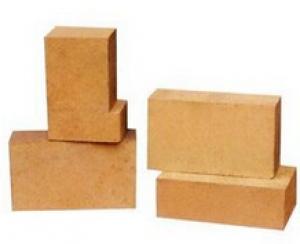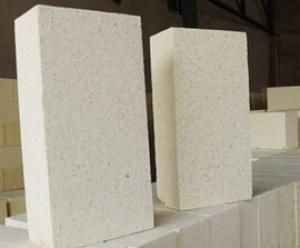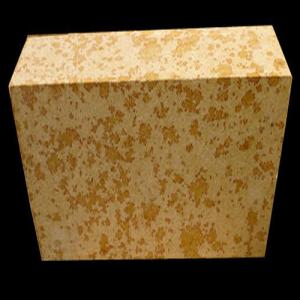High Temperature Silica Refractory Brick for Glass Kiln
- Loading Port:
- Tianjin
- Payment Terms:
- TT OR LC
- Min Order Qty:
- 1 m.t.
- Supply Capability:
- 10000000 m.t./month
OKorder Service Pledge
OKorder Financial Service
You Might Also Like
Features:
1.Good acid and erosion resistance, powerful anti high-temperature strength.
2.Soften melting temperature is 1620~1670 °C.
3.Low thermal shock resistance.
4.Natural silica as raw material, plus regular mineralizer.
5.Ensure good bonding and structural strength of furnace.
6.Good heat resistance and long service life.
Application:
1.Glass melting furnace, ceramic frit kiln, sodium silicate furnace, soaking furnace, ceramic kiln, etc
2.Coke oven's coking chamber, combustion chamber walls, steel open-hearth's regenerator and sediment chamber, etc.
3.Load-bearing parts of high temperature hot air furnace and acid open-hearth furnace roof, etc.
Item | Properties | |||
BG-96A | BG-96B | BG-95A | BG-95B | |
SiO2,% | 96 | 96 | 95 | 95 |
Fe2O3 ,% | 0.8 | 1.0 | 1.2 | 1.2 |
Melt index,% Unit weight<20kg< span=""> Unit weight≥20KG |
0.5 0.6 |
— — |
0.7 0.7 |
— — |
Cold Crushing strength MPa, Unit weight<2kg< span=""> Unit weight≥20KG |
35(30) 30(25) | |||
Softening temperature under load,°C | 1680 | 1670 | 1660 | 1650 |
Apparent porosity % | 22(24) | |||
Bulk density,g/cm3 | 1.85-1.9 | |||
True density,g/cm3 | 2.34 | 2.35 | ||
Application | sodium silicate furnace,ceramic frit furnace ,glass furnace,coking furnace, metallurgical furnace and other furnaces | |||
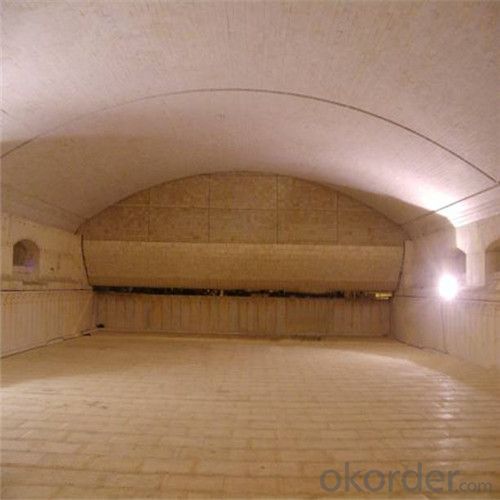

Q3: Can you offer Door-to-Door delivery?
A3: Yes, but only for some countries such us U.S., UAE, Saudi Arabia, Iran, and Russia, etc.
Q4: What is the minimum quantity?
A4: There is no minimum order quantity. Depending on the item and processing, there may be a minimum production required, however we can offer a quotation based only on the quantity you need.
Q5: Can you give me a brief introduction of the application of your products?
A5: CNBM (China National Building Material) core refractory business comprises the production, sale and installation of high-grade refractory products, the development and implementation of customized system solutions as well as rendering outstanding services for the key industries in Glass, Iron& Steel, Petrochemical, Cement, Ceramic and Nonferrous Metals.
- Q:How to judge the quality of brick, clay brick, high alumina brick furnace from the appearance?
- Mainly depends on the color and density of brick. Another black clay brick and brick with iron oxide formation and how much the size of bricks
- Q:The chemical composition of silica brick and its physicochemical index?
- Brick refers to the refractory products in more than 93% of the content of SiO2
- Q:What are the main constituents of refractory bricks?
- Clay brick and clay brick are mainly composed of mullite (25% ~ 50%), glass phase (25% ~ 60%) and square quartz and quartz (up to 30%). Usually with hard clay as raw material, pre calcined mature material, and then with soft clay, semi dry or plastic molding, the temperature at 1300~1400 C fired clay brick products. Can also be added a small amount of water, glass, cement and other binders to make non burning products and amorphous materials. It is a refractory brick commonly used in blast furnaces, hot blast furnaces, heating furnaces, power boilers, lime kilns, rotary kilns, ceramics and refractory bricks.
- Q:Glass kiln brick for physical and chemical indicators?
- Glass kiln with high quality silica brick with silicon oxide content, low melt index, mainly used for glass kiln crown, parapet, wall hanging, small furnace arch superstructure and regenerator.
- Q:Semisilica brick interpretation
- High temperature volume stability. Volume change is small.
- Q:Because of the recent relates to this industry, by way of learning to name for all raw materials, I hope knowledgeable friends exhibitions, thank you.
- Acidic materialMainly siliceous materials, such as quartz, tridymite and cristobalite, chalcedony, flint, opal, white quartzite, silica sand, diatomaceous earth, silicon oxide contained in these siliceous materials (SiO2) at least 90%, pure raw materials are silicon oxide as high as 99% or more. Siliceous materials at high temperature is the acidic nature of chemical dynamics, when the presence of metal oxide, or when in contact with the chemical reaction, and combined with a fusible silicate. Therefore, if there is a small amount of metal oxide in siliceous material, it will seriously affect its thermal resistance.
- Q:Semisilica brick, clay brick, high alumina brick and what is the difference?
- The share of A12O3 and SiO2 is different
- Q:The specific content is what gb/t2608-2012 brick
- The provisions of the brick classification, technical requirements, test methods,
- Q:How to improve the thermal conductivity of the coke silicabrick rate?
- The content of SiO2 is 98.23% crystalline silica as raw material, with sulfite pulp liquid as binder, millscale and lime as mineralizer, by Jin Hongshi (TiO2) as additive, can improve the rate of thermal conductivity of silica brick for coke oven. When the rutile content is 1.5%, the coefficient of thermal conductivity of silica brick for coke oven is 2.66W/ (m.k).
- Q:The introduction of silica brick
- An acid refractory consisting mainly of quartz and square quartz and a small amount of residual quartz and glass.More than 94% silica content. True density 2.35g/cm3. With acid resistance, slag erosion performance. Higher high temperature strength. The softening start temperature is 1620~1670 degrees. Long term use at high temperature without deformation. The thermal shock resistance is low (the heat exchange in water is 1~4 times). The natural silica is used as the raw material, and a proper amount of mineralizer is used to promote the transformation of quartz into quartz in the body. Slowly sintered at 1350~1430 DEG C in the reducing atmosphere. When heating up to 1450 degrees, the total volume of 1.5~2.2% expands, and the residual expansion can close the kerf and ensure the airtight and structural strength of the masonry.
1. Manufacturer Overview |
|
|---|---|
| Location | |
| Year Established | |
| Annual Output Value | |
| Main Markets | |
| Company Certifications | |
2. Manufacturer Certificates |
|
|---|---|
| a) Certification Name | |
| Range | |
| Reference | |
| Validity Period | |
3. Manufacturer Capability |
|
|---|---|
| a)Trade Capacity | |
| Nearest Port | |
| Export Percentage | |
| No.of Employees in Trade Department | |
| Language Spoken: | |
| b)Factory Information | |
| Factory Size: | |
| No. of Production Lines | |
| Contract Manufacturing | |
| Product Price Range | |
Send your message to us
High Temperature Silica Refractory Brick for Glass Kiln
- Loading Port:
- Tianjin
- Payment Terms:
- TT OR LC
- Min Order Qty:
- 1 m.t.
- Supply Capability:
- 10000000 m.t./month
OKorder Service Pledge
OKorder Financial Service
Similar products
New products
Hot products
Related keywords
